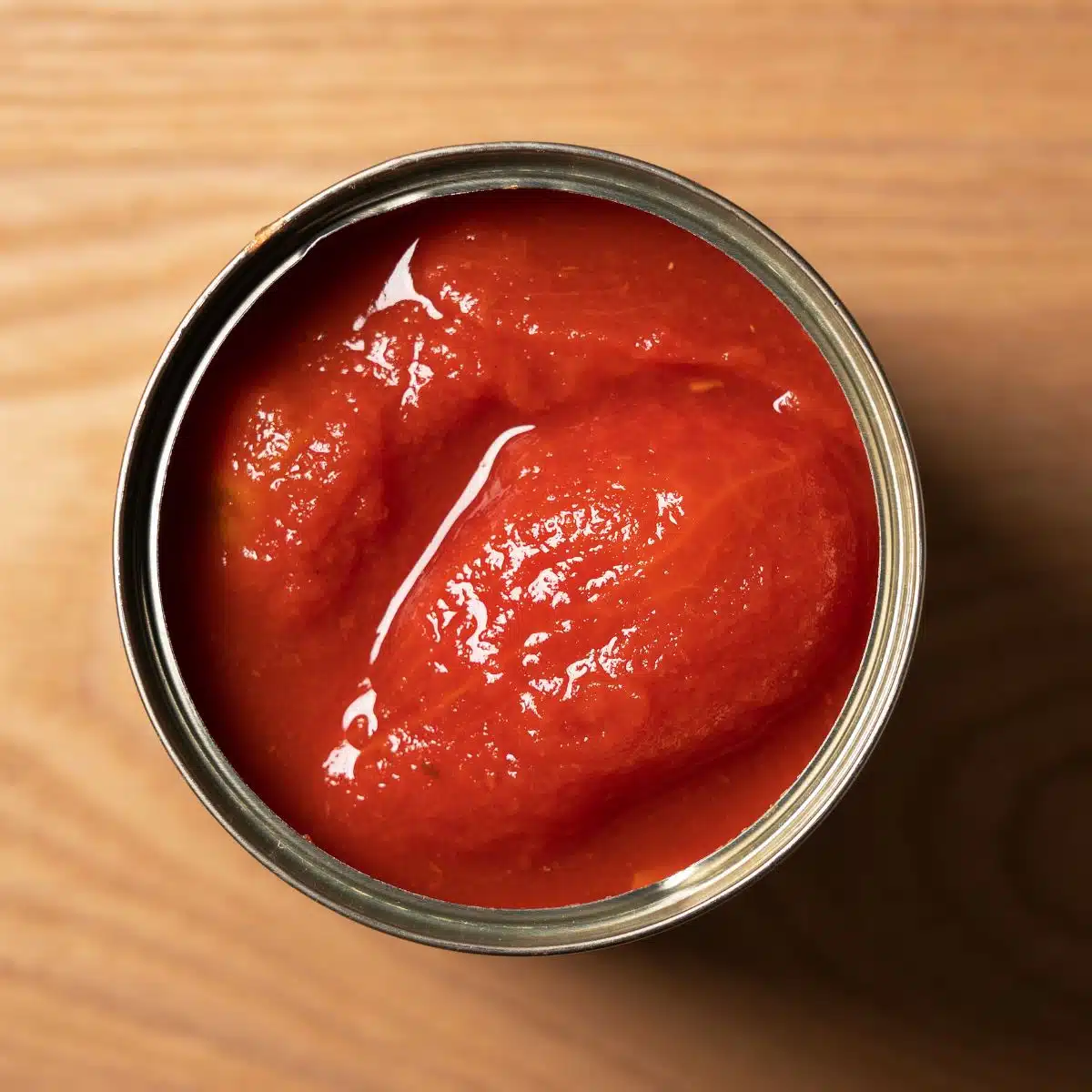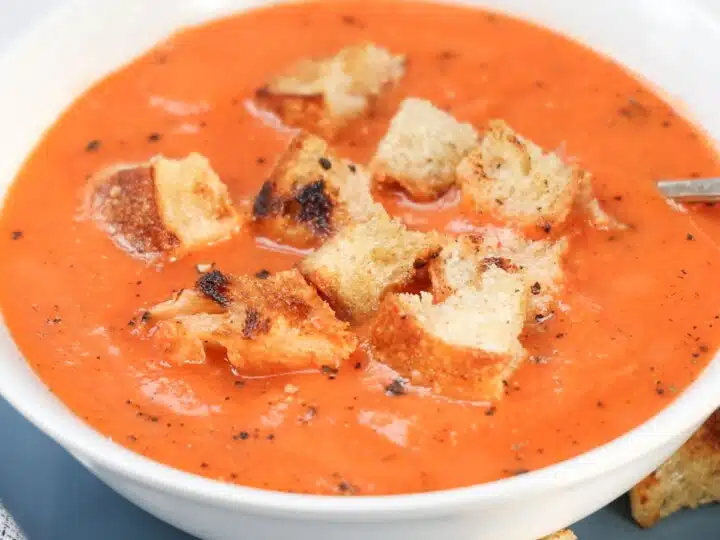Hello canned tomatoes! When it comes to canned foods, there are practically none that come close to the taste of their fresh counterparts – peas, green beans, carrots — you know what I’m talking about. But there’s one product that when done right, can get pretty darn close—canned tomatoes.

Jump to:
Why canned tomatoes are good
Well, it’s a process that’s been tweaked and perfected over time. Tomatoes that are destined for canning are grown specifically for flavor, harvested at their height of ripeness, and quickly processed to retain their fresh, juicy flavor. Top quality brands, like Muir Glen and Mutti, take a lot of care to preserve tomatoes so their peak flavor can be brought out at any time of year with just the turn of a can opener.
For that reason, I always keep a good stash on hand—mostly whole-peeled as you can turn these into any type, but also cherry, crushed, diced, and paste—because when you open the cabinets to figure out what’s for dinner, they’re sitting there ready to save the day. And that’s hard to say that about many other canned panty items.
Using Canned Tomatoes
There are so many dishes that you can create with canned tomatoes—sauces, braises, salsas, and stews, just to name a few. Some of my favorite go-tos are a creamy homemade soup (just add grilled cheese!), skillet chicken puttanesca, pasta ala vodka, a weekday pomodoro sauce, and one of my all-time favorites, shakshuka.
Canned Tomato Primer

Walk into any grocery store and you’ll find an entire aisle of tomato products. So, what are the best canned tomatoes to buy?
- Whole peeled tomatoes are harvested at their peak, removed of their skins and packed in tomato juices or purée. These are my go-to variety and the most versatile you can buy because they can be transformed into some of the products below by simply crushing them with your hands or dicing them up.
- Diced tomatoes are chopped prior to canning and then processed with calcium chloride and citric acid to help the pieces keep their shape. As a result, they're firmer than either whole or crushed tomatoes, so even though you'd expect the smaller pieces to break down quicker in cooking, the opposite happens. I don’t use these much, but opt instead to chop whole, peeled tomatoes.
- Crushed tomatoes are usually mixed with tomato puree or tomato juice, which makes them saucier than diced tomatoes, yet still chunkier than full-on tomato sauce. The texture can vary greatly depending on the brand, from chunky to a purée. Also, it’s easy to crush whole, peeled tomatoes yourself.
- Stewed tomatoes have been cooked and seasoned with herbs, spices, sugar, and other flavorings like celery, onions, and peppers prior to being canned. They're typically softer and sweeter than whole tomatoes. I’m not a fan of these.
- Puréed tomatoes have been seeded, cooked and strained into a thick sauce. They are similar to crushed tomatoes, but have a bit thicker consistency. This product makes a good shortcut for quick-cooking sauces.
- Tomato sauce has been cooked and blended into a very smooth sauce with a concentrated tomato flavor (more than tomato purée, less than tomato paste). It is not the same as marinara sauce.
- Tomato paste is made by cooking down tomatoes until all the juice has evaporated and the tomatoes have developed a dark red color and concentrated flavor. This product is a great flavor enhancer and thickener, and a little goes a long way.
For me, diced tomatoes are too firm, crushed tomatoes are too inconsistent, and tomato purée is too cooked— which is why in my pantry, you'll only see whole peeled tomatoes packed in juice (I prefer Muir Glen and Cento brands) and tomato paste.
Choosing Canned Tomatoes
When choosing canned tomatoes, less is more. On a label, you want to see the fewest ingredients possible: tomatoes, salt (but not too much) and water or tomato juice. A little citric acid is okay because that's part of the canning process, but if you see high fructose corn syrup, any preservatives you can’t pronounce, or flavorings like basil, pepper, garlic, choose another brand. For the best flavor, you want them to be as pure as possible.
What are San Marzano Tomatoes?

San Marzano tomatoes are considered the Ferrari of canned tomato varieties and are famed for their balanced flavor that combines sweetness, tomatoey intensity and just the right amount of acid. Loyalists say they are well worth the higher price tag compared to other canned tomatoes.
True San Marzano tomatoes are grown in a specific region of Italy: The Agro Sarnese Nocerino of the Sarno River valley near Mount Vesuvius, where volcanic soils are said to produce sweeter, less acidic tomatoes. And if they are grown in this region, they’re given an official status as a “protected designation of origin” or D.O.P. (Denominazione d’Origine Protteta). But beware, as any producer can slap the words “San Marzano” on their label and charge a premium, whether those tomatoes come from the certified D.O.P or not.
Slow-Roasted Canned Tomatoes

If you want to intensify the tomato flavor even more, try slow-roasting whole, peeled canned tomatoes. As the water evaporates, the flavor becomes more concentrated, yielding a deeper, caramelized tomato flavor (directions below.)
Drain a 28-ounce can of whole tomatoes. Cut the tomatoes in half and arrange in a single layer on a parchment-lined rimmed baking sheet. Season with salt and drizzle with olive oil. You can also scatter some herb sprigs over them like, rosemary or thyme, or add some sliced fresh garlic. Bake at 300°F until the excess juices have evaporated and tomatoes look slightly dry on the exterior but still moist within, 1 to 2 hours (check after 1 hour).TIP
If you want to intensify the tomato flavor even more, try slow-roasting whole, peeled tomatoes. As the water evaporates, the flavor deepens and becomes more concentrated, yielding an amazing flavor.
Sign-up for The Flavor Journal Newsletter and Get a Free e-book!

Let's connect!
Be sure to FOLLOW US on FACEBOOK, INSTAGRAM, TIKTOK, and PINTEREST Many thanks!








Leave a Comment